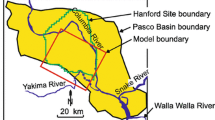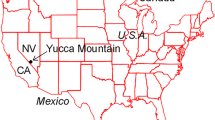Abstract
The medium-level radioactive waste deposited in the Asse 2 salt mine, Germany, has a total activity of 1.2 × 1015 Bq (1 January 2002). The waste lies in a former mining chamber on the −511 m mining level close to the contact between the Mesozoic country rock and the Zechstein salt dome. The Mesozoic country rock is strongly faulted but the geometry of the fault pattern is incompletely known. Two tectonic cases are considered: a pessimistic case, which assumes that the radioactive source is linked to the surface by a single fault, and an optimistic case, which assumes that the radioactive source is not connected to any fault at all. The potential groundwater contamination by radioactive fluids expelled from the cavity is simulated with the TOUGH2 code for periods of up to 6,000 years, when the potential contamination reaches its greatest vertical extent. Two types of driving forces are considered: convergence of the rock salt surrounding the cavity and generation of H2 gas by the corrosion of iron, steel and other metallic components of the waste at low O2 fugacities. Rock-salt creep has the greatest potential impact, as it leads to a radioactive plume whose 1 Bq/L activity contour rises up to 240 m below the surface in the pessimistic tectonic case. The value of the model for the assessment of the environmental risk is limited. The knowledge of the hydrogeological situation is incomplete and the pessimistic tectonic case may not be pessimistic enough for a realistic worst-case scenario.








Similar content being viewed by others
References
Batsche H (written communication 1994) Hydrogeologisches Forschungsprogramm Asse. Institut für Tieflagerung, Braunschweig, Germany, unpublished report, various paginations
Batsche H, Klarr K, von Stempel C (1979) German geological exploration and hydrology of Asse II. Proceedings US/FRG Bilateral Workshop 1979. Waste isolation performance assessment and in situ testing. Hahn-Meitner Institut für Kernforschung, Berlin, Germany, pp 133–155
Bossy H (2006) The closure of the Asse research mine. http://www.bmu.de/files/pdfs/allgemein/application/pdf/jc_asse.pdf. Accessed 11 July 2007
Brooks RH, Corey AT (1964) Hydraulic properties of porous media. Hydrology Papers Colorado State University Fort Collins, USA, 3:1–27
Corey AT (1954) The interrelation between gas and oil relative permeabilities. Producer’s Monthly, vol. 19, no. 1, November 1954 (quoted by Brooks and Corey 1964)
Doherty J (2000) PEST—model-independent parameter estimation. Watermark Numerical Computing, Australia, various paginations
Finsterle S (2000) iTOUGH2 user’s guide. Earth Sciences Division, Lawrence Berkeley National Laboratory, University of California, Berkeley, USA, p 130
GSF (2006) Asse—ein Bergwek wird geschlossen. GSF-Forschungszentrum für Umwelt und Gesundheit, München, Germany. www.gsf.de. Accessed 11 July 2007
Hensel G (2001) Geologie und Langzeitsicherheitsnachweis. Dokumentation Fachgespräch zur Situation im Atommüll-Endlager Asse II, 20 October 2001, Kirchencampus, Wolfenbüttel, Germany. http://www.aufpassen.org/fachtagung01/INHALT.HTM. Accessed 2 April 2008
Hensel G (2005) Das Schießungskonzept der Schachtanlage Asse II und der Stand der Arbeiten zum Langzeitsicherheitsnachweis. Dokumentation 2. Fachgespräch zur Situation im Atommüll-Endlager Asse II, 23 April 2005, Kirchencampus, Wolfenbüttel, Germany. http://www.aufpassen.org/fachtagung05/Hensel.html. Accessed 3 April 2008
Herbert AW, Jackson CP, Lever DA (1988) Coupled groundwater flow and solute transport with fluid density strongly dependent upon concentration. Water Resour Res 24:1781–1795
Hirsekorn RP, Nies A, Rausch H, Storck R (1991) Performance assessment of confinements for medium-level and α-contaminated waste (PACOMA Project). GSF report 12/9, GSF-Forschungszentrum für Umwelt und Gesundheit, Braunschweig, Germany, Various paginations
Hoffmann S (1993) Zeitreihenanalyse von Grundwasserstands-, Quellschüttungs—und Temperaturganglinien im Rahmen hydrogeologischer Untersuchungen am Forschungsbergwerk Asse. Unpublished thesis (Diplomarbeit), part 2, Christian-Albrechts-Universität, Kiel, Germany, p 105
Javeri V (1998) Combined gas and nuclide transport in a two dimensional repository considering a variable rock convergence. Proceedings, TOUGH Workshop ‘98, 4–6 May 1998, Earth Sciences Division, Lawrence Berkeley National Laboratory, University of California, Berkeley, USA, pp 77–82
Javeri V (2006) Three-dimensional analyses of coupled gas, heat and nuclide transport in a repository including rock salt convergence. Proceedings, TOUGH Symposium 2006, 15–17 May 2006, Lawrence Berkeley National Laboratory, Berkeley, California, USA, p 9
Johns RT, Rivera A (1996) Comment on dispersive transport dynamics in a strongly coupled groundwater-brine flow system by Curtis M. Oldenburg and Karsten Pruess. Water Resour Res 32:3405–3410
Kappei G (2001) Abriss der Geschichte der Schachtanlage Asse II. Dokumentation Fachgespräch zur Situation im Atommüll-Endlager Asse II, 20 October 2001, Kirchencampus, Wolfenbüttel, Germany. http://www.aufpassen.org/fachtagung01/INHALT.HTM. Accessed 2 April 2008
Kappei G (2007) Forschungsbergwerk Asse. http://www.gsf.de/asse/neu/6a.php. Accessed 29 May 2007
Klarr K, Richter-Bernburg G, Rothfuchs T (1987) Der Zechstein in der Asse südöstlich Braunschweig und geowissenschaftliche Versuche zur Endlagerung hochradioaktiver Abfälle. Internationales Symposium Zechstein 87, Wiesbaden, Germany (quoted by Hoffmann 1993)
Konikow LF, Sanford WE, Campbell PJ (1997) Constant-concentration boundary condition: lessons from the HYDROCOIN variable-density groundwater benchmark problem. Water Resour Res 33:2253–2261
Meyer H (2002) Das Radionuklidinventar in der Schachtanlage Asse. Informationsveranstaltung des GSF-FB Asse, 24 October 2002, Remlingen, Germany. http://www.gsf.de/asse/info2. Accessed 3 July 2007
NAGRA (2002) Project opalinus clay—safety report. NAGRA technical report 02–05. Wettingen, Switzerland, various paginations
NMU (2008) Statusbericht des Niedersächsischen Ministeriums für Umwelt und Klimaschutz über die Schachtanlage Asse II. Hannover, Germany, 1 September 2008. http://cdl.niedersachsen.de/blob/images/C49474425_L20.pdf (Accessed 27 October 2008)
Oldenburg CM, Pruess K (1995a) Dispersive transport dynamics in a strongly coupled groundwater-brine flow system. Water Resour Res 31:289–302
Oldenburg CM, Pruess K (1995b) Strongly coupled single-phase flow problems: effects of density variation, hydrodynamic dispersion, and first order decay. Paper presented at the TOUGH Workshop ‘95. Earth Sciences Division, Lawrence Berkeley Laboratory, University of California, Berkeley, USA, 20–22 March 1995, p 6
Oldenburg CM, Pruess K, Travis BJ (1996) Reply to Comment on dispersive transport dynamics in a strongly coupled groundwater-brine flow system. Water Resour Res 32:3411–3412
Pruess K, Oldenburg C, Moridis G (1999) TOUGH2 user’s guide, Version 2.0. Earth Sciences Division, Lawrence Berkeley National Laboratory, University of California, Berkeley, USA, p 198
Rasmussen TC (2001) Pressure wave vs. tracer velocities through unsaturated fractured rock. In: Evans DD, Nicholson TF, Rasmussen TC (eds), Flow and transport through unsaturated fractured rock, 2nd edn. American Geophysical Union Geophysical Monograph 42, pp 45–52
Schönfeld E (1986) Die Grundwasserbewegung im Deckgebirge und am Salzspiegel des Salzstocks Asse. GSF-Bericht 26/86, Neuherberg, Germany, p 107
SKB (2006) Long-term safety for KBS-3 repositories at Forsmark and Laxemar—a first evaluation. SKB Technical Report TR-06-09, Stockholm, Sweden, p 620
Stenhouse MJ (1995) Sorption databases for crystalline, marl and bentonite for performance assessment. NAGRA technical report 93–06, Wettingen, Switzerland, p 107
Storck R, Aschenbach J, Hirsekorn RP, Nies A, Stelte N (1988) PAGIS performance assessment of geological isolation systems for radioactive waste: disposal in salt formations. Office for Official Publications of the European Communities, Luxembourg, p 788
Storck R, Buhmann D, Hirsekorn RP, Kühle T, Lührmann L (1996) Das Programmpaket EMOS zur Analyse der Langzeitsicherheit eines Endlagers für radioaktive Abfälle, Version 5. Gesellschaft für Anlagen-und Reaktorsicherheit, Köln, Germany, p 345
Taylor T (2001) Schachtanlage Asse—Die hydrogeologische Situation. http://www.helmholtz-muenchen.de/asse/veranstaltungen/1-infoveranstaltung/index.html. Accessed 2 April 2008
Tholen M (2002) Materialien in den eingelagerten radioaktiven Abfällen der Schachtanlage Asse. Informationsveranstaltung des GSF-FB Asse, 24 October 2002, Remlingen, Germany. http://www.gsf.de/asse/info2. Accessed 3 July 2007
Wallmüller R (2001) Schachtanlage Asse—Die geologische Situation. http://www.helmholtz-muenchen.de/asse/veranstaltungen/1-infoveranstaltung/index.html. Accessed 2 April 2008
Xu T, Sonnenthal E, Spycher N, Pruess K (2005) TOUGHREACT user’s guide: a simulation program for non-isothermal multiphase reactive geochemical transport in variably saturated geologic media. Earth Sciences Division, Lawrence Berkeley National Laboratory, University of California, Berkeley, USA, p 195
Acknowledgments
The investigations benefited from the advice given by K.-H. Krieger (Landesamt für Bergbau, Energie und Geologie, Hannover, Germany), who has an intimate knowledge of the hydrogeology of the Asse area. Two anonymous reviewers provided valuable suggestions, especially with respect to risk assessment.
Author information
Authors and Affiliations
Corresponding author
Rights and permissions
About this article
Cite this article
Schwartz, M.O. Modelling groundwater contamination above the Asse 2 medium-level nuclear waste repository, Germany. Environ Earth Sci 59, 277–286 (2009). https://doi.org/10.1007/s12665-009-0025-5
Received:
Accepted:
Published:
Issue Date:
DOI: https://doi.org/10.1007/s12665-009-0025-5




